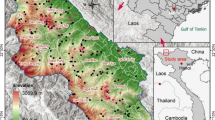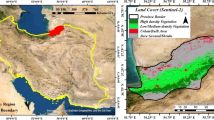Abstract
Frequent and intense forest fires have posed severe challenges to forest management in many countries worldwide. Since human experts may overlook important signals, the development of reliable prediction models with various types of data generated by automatic tools is crucial for establishing rigorous and effective forest firefighting plans. This study applied recently emerged ensemble learning methods to predict the burned area of forest fires and the occurrence of large-scale forest fires using the forest fire dataset from the University of California, Irvine machine learning repository collected from the northeastern region of Portugal. The results showed that the tuned random forest approach performed better than other regression models did with regard to the prediction accuracy of the burned area. In addition, extreme gradient boosting outperformed other classification models in terms of its predictive accuracy of large-scale fire occurrences. The findings showed that ensemble learning methods not only have great potential for broader application in forest fire automatic precaution and prevention systems but also provide important techniques for forest firefighting decision making in terms of fire resource allocation and strategies, which can ultimately improve the efficiency of forest fire management worldwide.






Similar content being viewed by others
Notes
The best RFt model setting was “max_depth = 40, ntrees = 200, sample_rate = 0.9, mtries = 4, col_sample_rate_per_tree = 0.9, and score_tree_interval = 10”.
The EGB settings were as follows: xgbGrid < - expand.grid(nrounds = c(1, 10), max_depth = c(1, 4), eta = c(.1, .4), gamma = 0, colsample_bytree = .7, min_child_weight = 1, and subsample = c(.8, 1)).
References
Food and Agriculture Organization of the United Nations (2015) Global forest resources assessment. www.fao.org/3/a-i4808e.pdf. Accessed 1 Feb 2017
Brushlinsky NN, Hall JR, Sokolov SV, Wagner P (2016) World fire statistics. www.ctif.org/ctif/world-fire-statistics. Accessed 1 Feb 2017
Stephens SL (2005) Forest fire causes and extent on United States Forest Service lands. Int J Wildland Fire 14:213–222. https://doi.org/10.1071/WF04006
Guo F, Innes JL, Wang G, Ma X, Sun L, Hu H, Su Z (2015) Historic distribution and driving factors of human-caused fires in the Chinese boreal forest between 1972 and 2005. J Plant Ecol 8:480–490. https://doi.org/10.1093/jpe/rtu041
Pyne SJ, Andrews PL, Laven RD (1996) Introduction to wildland fire, 2nd edn. Wiley, Lonson
Cortez P, Morais AdJR (2007) A data mining approach to predict forest fires using meteorological data. In: Neves JM, Santos MF, Machado JM (eds) New trends in artificial intelligence: proceedings of the 13th Portuguese conference on artificial intelligence (EPIA 2007), Guimarães, Portugal, [Lisboa]: APPIA, 2007. ISBN 978-989-95618-0-9, 2007. pp 512–523
Arrue BC, Ollero A, de Dios JRM (2000) An intelligent system for false alarm reduction in infrared forest-fire detection. IEEE Intell Syst 15:64–73. https://doi.org/10.1109/5254.846287
Piñol J, Terradas J, Lloret F (1998) Climate warming, wildfire hazard, and wildfire occurrence in coastal eastern Spain. Clim Change 38:345–357. https://doi.org/10.1023/A:1005316632105
Castelli M, Vanneschi L, Popovič A (2015) Predicting burned areas of forest fires: an artificial intelligence approach. Fire Ecol 11:106–118. https://doi.org/10.4996/fireecology.1101106
Angayarkkani K, Radhakrishnan N (2009) Efficient forest fire detection system: a spatial data mining and image processing based approach. Int J Comput Sci Netw Sec 9:100–107
Pourtaghi ZS, Pourghasemi HR, Aretano R, Semeraro T (2016) Investigation of general indicators influencing on forest fire and its susceptibility modeling using different data mining techniques. Ecol Ind 64:72–84. https://doi.org/10.1016/j.ecolind.2015.12.030
Hr Pourghasemi, Beheshtirad M, Pradhan B (2016) A comparative assessment of prediction capabilities of modified analytical hierarchy process (M-AHP) and Mamdani fuzzy logic models using Netcad-GIS for forest fire susceptibility mapping. Geomat Nat Hazards Risk 7:861–885. https://doi.org/10.1080/19475705.2014.984247
Saoudi M, Bounceur A, Euler R, Kechadi T (2016) Data mining techniques applied to wireless sensor networks for early forest fire detection. In: proceedings of the international conference on internet of things and cloud computing. ACM, New York. p 71
Stojanova D, Panov P, Kobler A, Džeroski S, Taškova K (2006) Learning to predict forest fires with different data mining techniques. In: Conference on data mining and data warehouses, Ljubljana
Wijayanto AK, Sani O, Kartika ND, Herdiyeni Y (2017) Classification model for forest fire hotspot occurrences prediction using ANFIS algorithm. IOP Conf Ser Earth Environ Sci 54:012059. https://doi.org/10.1088/1755-1315/54/1/012059
Amatulli G, Rodrigues MJ, Trombetti M, Lovreglio R (2006) Assessing long-term fire risk at local scale by means of decision tree technique. J Geophys Res Biogeosci. https://doi.org/10.1029/2005JG000133
Vasconcelos M, Silva S, Tomé M, Alvim M, Pereira J (2001) Spatial prediction of fire ignition probabilities: comparing logistic regression and neural networks. Photogramm Eng Remote Sens 67:73–81
Vega-Garcia C, Lee BS, Woodard PM, Titus SJ (1996) Applying neural network technology to human-caused wildfire occurrence prediction. AI Appl 10:9–18
Mazzoni D, Tong L, Diner D, Li Q, Logan J (2005) Using MISR and MODIS data for detection and analysis of smoke plume injection heights over North America during summer 2004. AGU Fall Meet Abstr 1:853
Massada AB, Syphard AD, Stewart SI, Radeloff VC (2012) Wildfire ignition-distribution modelling: a comparative study in the Huron–Manistee National Forest, Michigan, USA. Int J Wildland Fire 22:174–183. https://doi.org/10.1071/WF11178
Zhou ZH (2015) Ensemble learning. In: Li SZ, Jain A (eds) Encyclopedia biometrics. Springer, New York, pp 411–416
Johnson NE, Ianiuk O, Cazap D, Liu L, Starobin D, Dobler G, Ghandehari M (2017) Patterns of waste generation: a gradient boosting model for short-term waste prediction in New York City. Waste Manag 62:3–11. https://doi.org/10.1016/j.wasman.2017.01.037
Chuvieco E, Aguado I, Jurdao S, Pettinari ML, Yebra M, Salas J, Hantson S, Riva J, Ibarra P, Rodrigues M, Echeverría M, Azqueta D, Román M, Bastarrika A, Martinez S, Recondo C, Zapico E, Martinez-Vega J (2012) Integrating geospatial information into fire risk assessment. Int J Wildland Fire 23:606–619. https://doi.org/10.1071/WF12052
Loepfe L, Martinez-Vilalta J, Piñol J (2011) An integrative model of human-influenced fire regimes and landscape dynamics. Environ Model Softw 26:1028–1040. https://doi.org/10.1016/j.envsoft.2011.02.015
Rodrigues M, de la Riva J (2014) An insight into machine-learning algorithms to model human-caused wildfire occurrence. Environ Model Softw 57:192–201. https://doi.org/10.1016/j.envsoft.2014.03.003
Hsu CW, Chang CC, Lin CJ (2003) A practical guide to support vector classification. Technical report, department of computer science and information engineering, University of National Taiwan, Taipei
Zhang C, Ma Y (2012) Ensemble machine learning: methods and applications. Springer, Berlin
Ishwaran H, Kogalur UB (2010) Consistency of random survival forests. Stat Probab Lett 80:1056–1064. https://doi.org/10.1016/j.spl.2010.02.020
Breiman L (2010) Random forests. Mach Learn 45:5–32. https://doi.org/10.1023/A:1010933404324
Cutler DR, Edwards TC Jr, Beard KH, Cutler A, Hess KT, Gibson J, Lawler JJ (2007) Random forests for classification in ecology. Ecology 88:2783–2792
Ghafouri-Kesbi F, Rahimi-Mianji G, Honarvar M, Nejati-Javaremi A (2017) Predictive ability of random forests, boosting, support vector machines and genomic best linear unbiased prediction in different scenarios of genomic evaluation. Anim Prod Sci 57:229–236. https://doi.org/10.1071/AN15538
Archibald S, Roy DP, Wilgen BWV, Scholes RJ (2009) What limits fire? An examination of drivers of burnt area in Southern Africa. Glob Change Biol 15:613–630. https://doi.org/10.1111/j.1365-2486.2008.01754.x
Wu Z, He HS, Yang J, Liu Z, Liang Y (2014) Relative effects of climatic and local factors on fire occurrence in boreal forest landscapes of Northeastern China. Sci Total Environ 493:472–480. https://doi.org/10.1016/j.scitotenv.2014.06.011
Oliveira S, Oehler F, San-Miguel-Ayanz J, Camia A, Pereira JMC (2012) Modeling spatial patterns of fire occurrence in Mediterranean Europe using Multiple Regression and Random Forest. For Ecol Manag 275:117–129. https://doi.org/10.1016/j.foreco.2012.03.003
Li C (2014) A Gentle introduction to gradient boosting. http://www.ccs.neu.edu/home/vip/teach/MLcourse/4_boosting/slides/gradient_boosting.pdf. Accessed 1 Feb 2017
Chen TQ, He T (2015) Xgboost: extreme gradient boosting. R package version 0.4-2. http://cran.fhcrc.org/web/packages/xgboost/vignettes/xgboost.pdf. Accessed 1 Feb 2017
Liaw A, Wiener M (2002) Classification and regression by random forest. R News 2:18–22
Louppe G, Geurts P (2012) Ensembles on random patches. In: Flach PA, Bie TD, Cristianini N (eds) Machine learning and knowledge discovery in databases. Springer, Berlin, pp 346–361
Arlot S, Genuer R (2014) Analysis of purely random forests bias. arXiv preprint arXiv 1407:3939
Chen TQ, Guestrin C (2016) XGBoost: a scalable tree boosting system. In: 22nd ACM SIGKDD international conference on knowledge discovery and data mining, ACM, New York, pp 785–794
Acknowledgements
This research was financially funded by the Ministry of Education in China (MOE)’s Project of Humanities and Social Sciences (Project No. 15YJCZH128).
Author information
Authors and Affiliations
Contributions
Ying Xie and Minggang Peng conceived and designed the experiment and collected and analyzed the data. Minggang Peng and Ying Xie wrote the original draft.
Corresponding author
Ethics declarations
Conflict of interest
The authors declare no conflict of interest.
Rights and permissions
About this article
Cite this article
Xie, Y., Peng, M. Forest fire forecasting using ensemble learning approaches. Neural Comput & Applic 31, 4541–4550 (2019). https://doi.org/10.1007/s00521-018-3515-0
Received:
Accepted:
Published:
Issue Date:
DOI: https://doi.org/10.1007/s00521-018-3515-0




